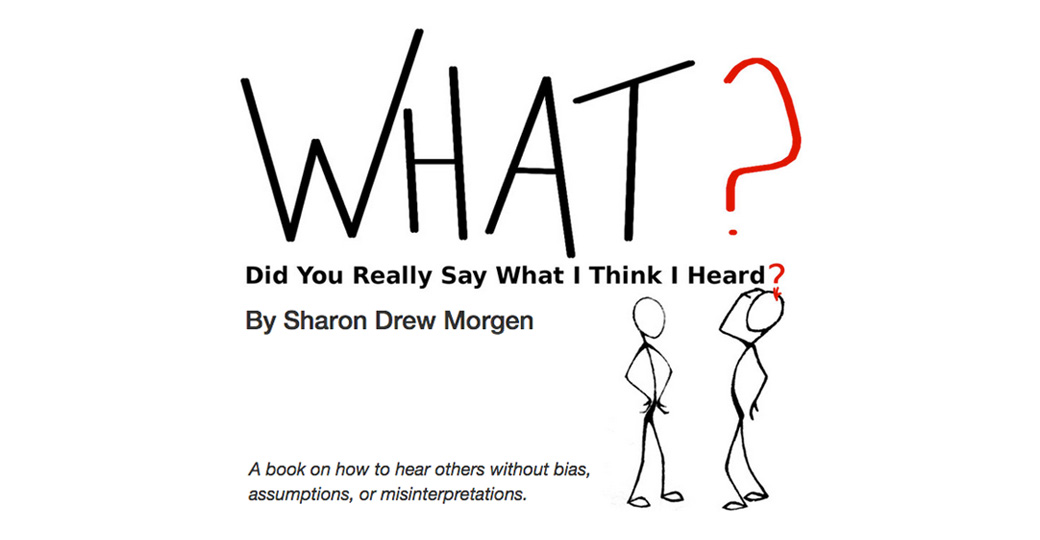The What of How: ‘Why’ and ‘What’ are inadequate to enable action
 When you’re conversing with a prospect, a teenager, or a team member, how does your brain choose the most effective words to connect your message to that particular person – and how do you know if there is a problem before it’s too late? How do you determine what to say, exactly, to effect real choice and change with folks who may have different mindsets and goals than you?
When you’re conversing with a prospect, a teenager, or a team member, how does your brain choose the most effective words to connect your message to that particular person – and how do you know if there is a problem before it’s too late? How do you determine what to say, exactly, to effect real choice and change with folks who may have different mindsets and goals than you?
We’ve been through decades of Why, then What. But without the How, the Why and What can’t initiate choice or change: Recent brain research has proven that humans actually have no conscious access to the associations that drive our beliefs, biases, or behaviors. How do we get to our own, and Other’s, unconscious to enable change? How do we go beyond our own beliefs, biases, and behaviors to enable all that’s possible in any communication? How?
CONVENTIONAL QUESTIONS AND LISTENING FAIL
To get to the unconscious and real change, our habitual skills are inadequate:
Questions: our natural curiosity and inquiry-based questioning processes are biased – posed by Questioners from their restricted subjective experience (and curiosity, and assumptions) and predisposed goals; our conscious curiosity restricts possible outcomes and butt up against the limits of our Communication Partner’s (CPs) biases, assumptions, history, expectations and knowledge base.
Listening: we only hear what CPs mean to convey (and they hear us) according to habitual filters (bias, assumptions, triggers, memory). I spent 3 years writing and researching a book on how our brains prefer to reject anything we hear that makes us uncomfortable.
Goals: ‘Gather information’ and ‘Understand’ are biased by our own goals and biased questions and listening skills. Plus, we may be making false assumptions:our CPs have no
TOOLS FOR HOW
Doing what we’re doing now, it’s hard to facilitate the How of change which demands that the underlying beliefs, values, agreements, and structural elements of a system (individual or group) must shift congruently. Here’s the How of unconscious change:
Beliefs vs. Behaviors: our behaviors are representations of our beliefs – our beliefs in action, if you will. And our beliefs are what makes each of us ecologically sound. Until or unless beliefs (mostly unconscious) are engaged, buy-in occurs, and any potential threats to the underlying system are managed, change will not happen. Too many of us – coaches, sellers, doctors, leaders, parents, to name a few – base our connections on offering and gathering information (which accesses conscious behavioral data) causing us to succeed only with CPs whose unconscious beliefs are aligned. Otherwise, we’re merely pushing good data into a closed system and facing resistance. This is where we lose buyers, fail coaching clients, offer unheeded information to patients or teens, and have difficulties collaborating, implementing, or changing. To enable change, we must have an array of unbiased communication tools to engage our own and our CPs unconscious beliefs, which can’t be done by gathering or offering information. [Note: information gathering and sharing is necessary once the unconscious is ready for change.]
Change: change occurs only when all of the elements (all) of our unconscious that have created and maintained our status quo buy-in to the new. If we try to push change without first getting buy-in, our unconscious thinks there’s a foreign element pushing in and rejects it. This is the problems with implementations: even when the change is ‘discussed’ beforehand, it faces resistance due to the nature of the ‘information-in’ approach without engaging the unconscious systems elements necessary.
Insider vs Outsider: only insiders can understand, figure out, and make their own changes. Facilitators are outsiders and can never understand the system that re-creates the status quo every moment.
‘HOW’ DEMANDS REACHING THE UNCONSCIOUS
I have spent decades developing a ‘How’ model that’s used at the front end of questioning, data gathering, and data exchange. I know most folks prefer their habitual skills, intuition, and experience; but they rationalize any failure by calling buyers stupid, or patients un-educated or lazy, or say that clients don’t really want to change. Rather than considering the possibility that it’s our own skill sets that need enhancement, we continue what we’re doing and built our failures in (i.e. a 4% close rate in sales is deemed ‘normal’) as ‘acceptable’.
The real How requires helping CPs engage and manage their own unconscious. Facilitators must stop trying to meet their own expectations and facilitate Others in reaching their own – their way. Offering advice, pitches or information doesn’t make a dent, and as Outsiders, we’ll never understand anyway.
As a student of ‘How’ since I’ve been 11 years old, I’ve spent decades developing (and then training to global corporations) a ‘How’ process by unwrapping and scaling my systemizing Asperger’s brain, using NLP as a structural frame, and studying systems and brain science (a very cursory explanation of my lifetime of study and trial). My material uses a sequenced process of unbiased, systemic questioning and listening that gets precisely to the unconscious to make change, choice, and new decisionspossible. I’m eager to teach the material to anyone involved in facilitating excellence (sellers,
Facilitative Questions: These questions engage unconscious systems and are NOT inquiry-based. They follow the brain’s sequence of systemic change, and use specific words, in a specific order, to engage specific elements of our unconscious in the specific path our systems take to reorganize around change without disruption. Note: these questions have been tested and trialed over 30 years.
Listening for Systems: We’ve never been taught to listen for the underlying system or metamessage or unconscious patterns that form the status quo. By hearing what’s meant we can formulate the right FQs. When listening for what we want to hear rather than what’s being meant, we circumvent success.
The Sequence of Change: There’s a generic, specific, systemic sequence that all change takes regardless of the circumstance (or industry, or situation. Change has identifiable, explicit, generic steps). Until or unless all elements (or stakeholders, or beliefs, etc.) are recognized, all the elements that maintain the status quo buy-in to change, and the system designs a route toward systems congruence, no change can occur.
Goals: We must become Change Facilitator first. Starting with ‘I need to know’ or ‘I seek a prospect with a need’ or ‘I need to offer this information’ impedes success. Without win/win, and Servant Leadership as goals, you’re a solution seeking a problem and merely find the low-hanging fruit.
WHAT TO DO?
So if you can’t ask questions, gather data, understand needs, or offer advice, what should you be doing instead? Here is the approach to How:
1. Enter as a Change Facilitator/Servant Leader. Help others examine their unique unconscious system of beliefs and biases to determine what’s missing within their system to reach Excellence in the area of your solution. Ultimately, they’ll need to recognize what’s standing in the way of them having the beliefs and steps to support the congruent change and determine a way forward that incorporates all (all) of their unique criteria – and maybe your solution. They do this anyway – just without you.
2. Begin the communication by listening for metamessages to trigger the
3. formulation of your Facilitative Questions that
4. lead your CPs through their unconscious status quo and enables them to discover
5. what’s missing (at the unconscious level) for Excellence to occur, and notice any incongruencies.
6. They must gather the appropriate people, policies, relationships, etc. and begin the change process. Once this is completed, THEN you can…
7. Ask information gathering questions or give advice to those who are able to change congruently.
Always remain in a Witness, or Observer stance to remain unbiased. Obviously there comes a time when gathering/sharing data, or offering important advice, is vital. But save it for end when there is a readiness for change. It’s a systems thing. And I can teach you how to do this.
If I had my way, every scientist, teacher, doctor, seller, coach, lawyer, leader, and parent would know how to do this. For me, we all should be Servant Leaders to each other to enable good decision making for effective interactions. Sellers can find the right prospects on the first call and attend meetings with every stakeholder present; marketers can enter the Buy Path much earlier in the decision cycle by using Facilitative Questions; parents/doctors can inspire appropriate action; leaders can eschew their biases and facilitate change without resistance. I’m here to help those companies and individuals interested in learning the How of change.
Uses: Questionnaires, prospecting, advertising, assessments, teaching, therapy, leadership, coaching, relationships, sales/marketing, prospecting, closing, coaching, implementations, decision science/analysis, negotiation, consulting, doc/patient, legal, meetings, presentations.
___________
Sharon Drew Morgen is the author of 9 books on decision facilitation, Buying Facilitation®, and listening. Her award winning blog (www.sharondrewmorgen.com) has 1600 articles on sales, facilitation, change, bias, listening, questions, etc. She has trained over 100,000 people in dozens of corporations globally, and is recognized as a visionary and thought leader. Sharon Drew trains, keynotes, consults, and coaches sellers, coaches, and leaders. www.didihearyou.com; www.dirtylittlesecretsbook.com 512 771 1117.sharondrew@sharondrewmorgen.
Sharon Drew Morgen April 25th, 2016
Posted In: Communication, Listening

